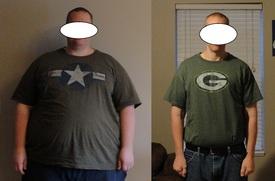Running vs. walking on incline
Replies
-
So today my coworker (who is super fit and helps people lose weight all the time) was telling me that when going to the gym i shouldnt be running. He said that in order to lose weight i should be walking on an incline for 30-60 minutes and that will burn more fat than doing hardcore cardio. Has anyone heard this or know if its true?
He's sort of a knucklehead, actually.
That said, when I'm lifting really heavy but need to add a bit of cardio to hit my cutting goals, walking is better than running because it doesn't affect my recovery. So I add walking not for it's magical fat burning abilities, but because I can do it without having to drastically lower my lifts.0 -
Azdak, each time this thread returns you return with common sense. Thank you :-)0
-
I prefer walking 3.5-4 mph on a 5-10 incline (depending on my energy level that day) because my knees and feet hurt too much when I run. I've found that walking tricks my mind into thinking that I'm not really working hard, so I always walk much longer than I can run. Just my two cents.

Walking doesn't beat your legs up as much. It's one of the reasons why cyclists can ride 3,4,5 hours every day and runners can't.
I've had at least 3 serious injuries in the past 4 years and incline walking is an important part of building back up and also keeping up a decent calorie burn when I can't run.
In fact I just finished burning 1026 calories in 60 min alternating 5 min running with 5 min walking using the random hill program on my treadmill. I've got the keyboard 1/2 covered with a towel while I type this so I don't sweat all over the keys.0 -
I have been walking at a 5 speed and a 9 incline on my treadmil for about two weeks now. I only do it for 30 min but I'm wore out by the end. My question is I already have muscular calfs (I'm a female). Will this make my legs even more bigger?0
-
^ NO0
-
What Azdak said.
But just to add - I've recently started walking on an incline for a number of reasons.
1) Convenience - I have a half mile hill literally at the end of my road and it's STEEP. I get up to 150bpm walking up it, which at 40 is pretty good going.
2) Low impact. I run, do Insanity, weights, met cons etc. But I really wanted something that would let me burn calories and fat but wouldn't waste my knees. This fits the bill perfectly.
3) Back to convenience - as it's so easy I don't find it difficult to pop out and get an hour workout in before breakfast (I'm NOT a morning person).
I walk up the hill (around 8 minutes) and down it (about 5) for a total of an hour. It's also a bit like an extended interval workout. By the top of it my calves and glutes are burning, I'm breathing hard and my heart rate is around 150+. Coming down I use different muscles but it gets back down to around 120 before I turn around and start going up again.
650 calories an hour last time I wore my HRM. Plus, my knees were fine and I actually felt refreshed after it rather than wasted (as I do after some of my runs etc).
I highly recommend walking up inclines. But there's a difference between walking up a steep hill and just tilting the treadmill a bit.
Well, you can get the treadmill up pretty steep, too.....
But you lay out the reasons why uphill walking can be such a good workout for many people. To me, one the most important is that it provides an excellent option for people whose fitness level is too high for level walking to represent an adequate workload intensity, but who do not to run or who cannot run.
Just don't hold on to the handrails.
I have to because if I got wobbly or fell off, I'd then get 0% of anything. I just want to point this out for people who complain about why is that person holding onto the rails. Some of us need to or still feel the need to after injuries. Don't judge. Just know that I know that it's less effective but better than nothing.0 -
I'm totally confused right now. Just thought I'd add that... and maybe come back to make sense of this later.0
-
Azdak-
how did you figure METs for these to be equal to 10 METs?
6 mph @ 0 incline
3.5 mph @ 13% incline, etc.
We were discussing this in our office, and couldnt figure out
4 mph @ _______% incline
4.5 mph @______% incline
5 mph @ _______% incline
5.5 mph @______% incline
I ask cause i jog / run 4.5 mph at 4.5% incline. Thx for your help 0
0 -
Azdak-
how did you figure METs for these to be equal to 10 METs?
6 mph @ 0 incline
3.5 mph @ 13% incline, etc.
We were discussing this in our office, and couldnt figure out
4 mph @ _______% incline
4.5 mph @______% incline
5 mph @ _______% incline
5.5 mph @______% incline
I ask cause i jog / run 4.5 mph at 4.5% incline. Thx for your help
There are standard equations for estimating energy expenditure for running and walking. Google "ACSM metabolic equations" and you should find a reference. You have yo go through several steps to get to "METs", but I don't think it is overly complicated.0 -
thank you Sir!
 0
0 -
There are many articles & studies that show incline training to be far superior to running on a flat surface.
http://woman.thenest.com/incline-training-weight-loss-14190.html
Freemotion.com has a pdf about incline training & the science of how it engages more muscles & burns more calories.
Jillian Michaels not only advocates incline training but uses it herself.
Try it & see. I love it and see FAST results! In my opinion 6 calories burned per minute is far better than 2!!!0 -
There are many articles & studies that show incline training to be far superior to running on a flat surface.
http://woman.thenest.com/incline-training-weight-loss-14190.html
Freemotion.com has a pdf about incline training & the science of how it engages more muscles & burns more calories.
Jillian Michaels not only advocates incline training but uses it herself.
Try it & see. I love it and see FAST results! In my opinion 6 calories burned per minute is far better than 2!!!
I appreciate your enthusiasm for incline walking. However, none of the references you cite really support your assertion that "incline training (is) far superior".
The first reference was not a study, but an article that made a number of false comparisons.
The first:For example, a 160-pound person walking at a brisk 3.5 mph would burn about 314 calories per hour, while the same person would burn 657 calories walking on a stair treadmill. The reason for the increased calorie burn is the amount of energy required to propel your body up a slope. It’s a tougher battle against gravity compared to exercising on a flat plane.
This statement is not comparing apples to apples. Walking at the same speed up an incline will ALWAYS burn more calories--because it is a higher intensity activity. Running 6.0 mph burns more calories than walking 3.5 mph also--for the same reason. This is the classic infomercial technique of lying by only telling partial truths.
The second:Inclined training burns a significant number of calories, and it also has an anaerobic effect. Ramping up the incline helps challenge your leg muscles far more than flat-plane exercise. While flat treadmill exercise activates about 20 percent of your leg muscle tissue, exercising at a 15-percent grade recruits about 75 percent of your leg muscle tissue. Muscle tissue naturally burns more calories compared to fatty tissue, so increasing the lean mass in your legs can help turn your body into a more efficient calorie burner. This leads to weight loss over time.
They obviously got their information from the study commissioned by Free Motion. This statement is basically a word salad that randomly combines fitness concepts without any understanding of what they mean. There is no "anerobic effect" (whatever that is). Recruiting more muscle fibers does nothing to "increase the lean mass" unless you are working those muscles to fatigue in a few repetitions--which you cannot do when performing thousands of repetitions walking. Any 'strength" gains achieved from walking up an incline are due to neuromuscular facilitation, not increased "mass".
The third:Exercising at an incline is one of the best ways to target and burn fat calories rather than your body’s main source of energy, carbohydrates.
The fuel substrate used during exercise has NO effect on stored body fat. If someone burns more fat calories during exercise, they will burn less the rest of the day so that, after 24 hours, there is no difference is total fax oxidation whether you do a "high carb" or "fat burning" workout.
The only honest/useful statement in this story is this one:a 2010 study conducted at Colorado State University found that slower-paced inclined training was as effective at helping people lose weight as faster-paced exercise on a flat surface. Inclined training was also found to be easier on the lower-body joints, knees, tendons and muscles.
This is the key benefit for incline walking, but that is because you performing exercise that is at a similar intensity as running, not because of any magic property of incline walking.
The second reference is primarily an advertisement for FreeMotion. They do reference one university study that Free Motion commissioned. There was no reference to whether that study had been published in a peer-reviewed journal. The results were interesting, but I would have to look at the actual study itself to determine exactly how the study was conducted and the results measured. However, the results that were reported (increased "fat burning", increased EMG activation) are irrelevant for either weight loss or muscle building.
There is no need to discuss the third reference.
There are benefits to incline walking - the two most important are: ability for higher-fit people to work at a high intensity and burn a lot of calories without the high-impact of running; less impact means less pounding/fatigue for the legs which means that it is often possible for persons without a lot of running endurance to engage in the higher-level activity for a longer duration or more frequently.
These two benefits are plenty--there is no need to make overstated, hyped-up and ultimately misleading claims of "superiority" for incline walking. The laws of physics still rule--which state that exercises done at the same intensity (i.e. oxygen uptake) will burn equal calories independent of modality.0 -
I'm a big advocate of walking and walking on an incline. I live where there are lots of hills and mountains so I prefer hiking and walking on hills but I will use a treadmill in the winter or when the weather is bad. I have pretty good muscle definition now in my calves. I also do leg weight training exercises 3 times a week. I much prefer walking to running. Both running and incline walking can be good exercises but for weight loss, I think walking is actually better since there are a lot more potential injuries with running. There is this super fit chick at my gym who does incline walking on the highest level and she looks way better and more toned than the joggers in my opinion. Running is also bad for your knees. Go to any hospital and you will find several people who have received knee or hip surgery from running. Swimming is also good for weight loss and toning that is low impact.0
-
Yes, u can hurt your knees or w/e running. Or u can learn 2 do it right and carefully. Outside in the fresh air, saying g'morning to people, watching the sun rise or set, watching the scenery change. So if ur gonna run, learn how 2 do it right.Running is also bad for your knees. Go to any hospital and you will find several people who have received knee or hip surgery from running.0 -
When I started out walking on an incline I always held on but I slowly increased the incline so I didn't need to. Holding on defeats the purpose for me so I now walk on 12.0 incline now at 3.5kph and the burn is great.
I also run so I mix it up during every workout and it never gets boring.0 -
BroScience strikes again.
I sometimes hold onto the handrails when I am gasping for breath after the sprint interval component of HIIT.0 -
I just wanted to point one thing out about holding onto the treadmill on an incline. If you are performing a target heart rate session, then you need to hold onto the grips which tell the treadmill what your HR is. If you don't, the treadmill will lower the incline and slow the pace.
With regards to running vs incline walking, I appreciate and agree with azdak.0 -
proof is in the pudding. If it works for you fine, but incline walking is amazing on the largest muscles of your body, quads. Also, I use Mark Lauren's "you are your own gym" to build more muscle and find that I no longer need expensive memberships. Mark has trained 1000s of special ops, and what is good enough for our military is way good enough for me;) I can do the exercise anywhere.
I'll try and get the info on the muscles worked in yayog, and with "weights". I believe there is a difference in numbers of. Denise0 -
Azdak, if you are still around, I would really like your input -- and of course anyone else who can help.
I am just a beginner with using the incline. Right now I am doing 3.6 mph and a 6% incline. I hold on to the handrails for dear life -- mostly psychological. But I do have short legs. I wear a HRM and since upping the incline from 5% to 6% I see that the intensity has increased dramatically for me and I am maintaining around 80-85% of my maximum heart rate. I am also losing weight quickly, and I am overweight. Since my heart rate is up high, indicating intensity, what difference does it make if I hold on to the handrails? I was thinking of slowing down my speed so that I can walk without holding on, but I worry I won't get the same intensity. Any input would be appreciated.0 -
Holding onto the handrails means you're supporting some fraction of your weight and stabilizing yourself with your arms rather than your legs. It decreases the intensity which is why the readout will be wrong - the machine typically calculates based on weight, incline, and speed and not heart rate.
So, if you reduce the incline and don't hold on, you will probably be close to the intensity you are now. Plus, you'll be working on your stability more 0
0 -
Thank you stealthg for your answer. I do not use the monitor on the machine. I follow the my heart rate on an HRM that I wrap around my chest. If the heart rate is up, doesn't that mean I am at high intensity regarding of holding hand rails or not? I heard that I would be working different muscles if I hold the hand rail, but I don't care about that. I only care about my heart rate intensity, which I thought would tell me how hard I am working. Any thoughts about that?0
-
Sure.
If you're walking at a steady pace, constant incline, then HR is a good relative indicator of intensity, particularly for the same workout or for workouts in a pretty short timeframe. It doesn't do so well at intervals - heart rate lags behind intensity changes and then doesn't recover as fast as intensity drops.
Here's a couple of points where you need to be careful with HR because changes aren't always reflective of intensity changes:- HR starts a slow steady increase about 5min into a workout even if intensity doesn't change. It's called cardiac drift.
- HR increases with increased temperature, stress, lack of sleep, pain, dehydration.
- HR decreases for the same intensity as you get more fit (up to a point), so it's best not to use it to compare intensities week to week - use the incline, speed, etc for that. You can use it to see your fitness improve for the same work, though.
- You probably won't use it for this, but by the same token, don't use it to compare intensities between people. Fitness matters and so does the range from min-max HR which can vary hugely. Because that range varies, be sure to calibrate your HRM if you want to use it for workout HR zones.
0 -
Thank you so much for your input! On the treadmill I am constant for the entire 60 minutes. Nothing changes other than my heart rate. OK..... I think I get it now. That was a good explanation. Thank you for sharing your knowledge.0
-
The body burns a higher percentage of calories from fat in the fat burning zone (60-65% of maximum heart rate) or at lower intensities.
At higher intensities (70-90% of your maximum heart rate), you burn a greater number of overall calories.
I had a personal trainer a few years ago who introduced me to walking on an incline. She said it was the best for fat burning. I set my treadmill to the highest incline possible (15%) and walk at a pace of 3.5 It really gets your heartrate up there and easier on the knees.
Running is not hard on your knees.........runners suffer no more arthritis etc than the general population, in fact there is a growing body of evidence that running may, in fact, protect your knees.
OP generally speaking running burns approximately twice the calories that walking does (race walking above 5 mph burns more due the mechanical inefficiency of maintaining that pace while always keeping one foot in contact with the ground) walking at higher inclines probably narrows that gap (I have yet to find a reliable calculator). If your goal is weight loss running works better. If your goal is fitness running works better.
If you hate running walking is good.
As to the whole "fat burning zone" that's really only important if you're training to for endurance events, even a skinny marathoner will have gar more calories available by way of stored fat compared to glycogen.0 -
BrianSharpe wrote: »The body burns a higher percentage of calories from fat in the fat burning zone (60-65% of maximum heart rate) or at lower intensities.
At higher intensities (70-90% of your maximum heart rate), you burn a greater number of overall calories.
I had a personal trainer a few years ago who introduced me to walking on an incline. She said it was the best for fat burning. I set my treadmill to the highest incline possible (15%) and walk at a pace of 3.5 It really gets your heartrate up there and easier on the knees.
Running is not hard on your knees.........runners suffer no more arthritis etc than the general population, in fact there is a growing body of evidence that running may, in fact, protect your knees.
OP generally speaking running burns approximately twice the calories that walking does (race walking above 5 mph burns more due the mechanical inefficiency of maintaining that pace while always keeping one foot in contact with the ground) walking at higher inclines probably narrows that gap (I have yet to find a reliable calculator). If your goal is weight loss running works better. If your goal is fitness running works better.
If you hate running walking is good.
As to the whole "fat burning zone" that's really only important if you're training to for endurance events, even a skinny marathoner will have gar more calories available by way of stored fat compared to glycogen.
When talking about knee deterioration (i.e. arthritis) it is true that running is not "hard on the knees". However, there is no disputing that running is a high-impact activity and the soft tissue injuries incurred with running are significantly higher than in lower-impact sports. To me, that's not an argument against running--one can take precautions to lessen the injury risk--but it's also something that is part of the discussion about the pros and cons of running.
0 -
chrismansa wrote: »Thank you stealthg for your answer. I do not use the monitor on the machine. I follow the my heart rate on an HRM that I wrap around my chest. If the heart rate is up, doesn't that mean I am at high intensity regarding of holding hand rails or not? I heard that I would be working different muscles if I hold the hand rail, but I don't care about that. I only care about my heart rate intensity, which I thought would tell me how hard I am working. Any thoughts about that?
I think another way to look at this is, you could try: Not holding on to the rails, and walking at a slower pace and/or lesser incline. I wouldn't be surprised if your HR didn't change much from what you're doing now.
This IMO would help with your balance and posture as well- All while getting to go "easier" and not holding on!0 -
Going up an incline is horrible for your knees so be careful on the choice you make0
-
Going up an incline is horrible for your knees so be careful on the choice you make0
-
chrismansa wrote: »Azdak, if you are still around, I would really like your input -- and of course anyone else who can help.
I am just a beginner with using the incline. Right now I am doing 3.6 mph and a 6% incline. I hold on to the handrails for dear life -- mostly psychological. But I do have short legs. I wear a HRM and since upping the incline from 5% to 6% I see that the intensity has increased dramatically for me and I am maintaining around 80-85% of my maximum heart rate. I am also losing weight quickly, and I am overweight. Since my heart rate is up high, indicating intensity, what difference does it make if I hold on to the handrails? I was thinking of slowing down my speed so that I can walk without holding on, but I worry I won't get the same intensity. Any input would be appreciated.
It's a valid point. The main reason why I caution against handrail support is because it results in inflated calorie readings if you are using the treadmill numbers. Another reason is that it prevents someone from fully developing their walking stride/balance, and holding on can result in diminishing returns--since you can negate part of the incline by grabbing harder, it takes more and more of an increase.
Increasing the speed or incline will increase the intensity, even with handrail support. The support will attenuate the increase, but it will still occur, as your HRM attests. You are then subject to the inaccuracies of the HRM which are often greater than the inaccuracy of the treadmill numbers. But, if you are monitoring your intensity with the HRM, then to some extent we are really talking about style points.
Keep in mind that you should be able to replicate any intensity with the right combination of speed and incline.
In other words, if 3.6 and 6% with handrail support is getting you to 80% of HRmax, then 3.0 mph and 6% might get you to the same place unsupported. Or 3.0/8%, or 2.8/10%--whatever is most comfortable.
Speed and incline tend to be inversely related--to maintain an intensity when slowing the speed, increase the incline and vice-versa. So, if your concern is not being able to maintain intensity when slowing the speed, you should be able to do that fairly easily by just increasing the incline. It will take a little time to get used to the steeper incline and the non-supported walking, but that should not be a big deal.
So, in the end, it's really your choice.0 -
Intervals (alternating run-walk) are less boring than just straight walking on a treadmill, which is mental torture to me. I personally prefer running to walking, although doing anything on a trail out in nature is FAR SUPERIOR to doing it on a treadmill.0
This discussion has been closed.
Categories
- All Categories
- 1.4M Health, Wellness and Goals
- 398.5K Introduce Yourself
- 44.7K Getting Started
- 261K Health and Weight Loss
- 176.4K Food and Nutrition
- 47.7K Recipes
- 233K Fitness and Exercise
- 462 Sleep, Mindfulness and Overall Wellness
- 6.5K Goal: Maintaining Weight
- 8.7K Goal: Gaining Weight and Body Building
- 153.5K Motivation and Support
- 8.4K Challenges
- 1.4K Debate Club
- 96.5K Chit-Chat
- 2.6K Fun and Games
- 4.8K MyFitnessPal Information
- 18 News and Announcements
- 21 MyFitnessPal Academy
- 1.5K Feature Suggestions and Ideas
- 3.2K MyFitnessPal Tech Support Questions


















